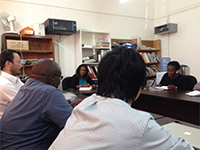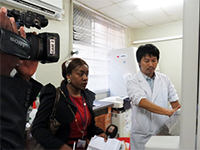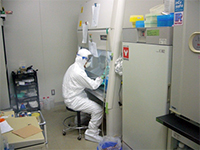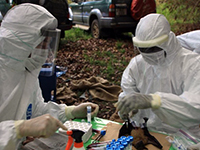Science and Technology Research Partnership for Sustainable Development (SATREPS) program http://www.jst.go.jp/global/english/
Ebola virus infections have reached historical levels in West Africa, predominantly in Sierra Leone, Liberia, and Guinea.
On August 17, 2014, Prof. Ayato Takada of the Research Center for Zoonosis Control, Hokkaido University in Japan and Principal Investigator of the “Surveillance of Viral Zoonoses in Africa” SATREPS project set off for Zambia on a mission to set up a system for testing suspected cases of Ebola virus infections.
Ebola virus disease has a case fatality rate of between 50 and 90 percent, the highest rate among known viral hemorrhagic fevers. As of September 3, 2014, no Ebola virus disease vaccine has been approved, and there are also no approved antivirals that can suppress the disease progression. Given these circumstances, on August 8, 2014, the World Health Organisation (WHO) declared that the outbreak constitutes an “extraordinary event” and a global public health risk, calling for a coordinated international response.
Zambia, where the SATREPS project is being conducted, has no confirmed cases of Ebola virus disease. Nevertheless, Zambia is surrounded by nations that have recorded outbreaks of Ebola or Marburg virus infections, including the Democratic Republic of the Congo, Angola, and Zimbabwe. Consequently, it is considered very likely that these viruses already exist in Zambia or will be brought into the country by human movements or by animals, including natural reservoirs of the virus. With the recent outbreak of Ebola virus disease in West Africa, it became necessary to rapidly prepare control measures in Zambia.
In these circumstances, the Zambian Ministry of Health has constituted an Ebola Virus Disease Rapid Response Preparedness Committee in preparation for potential Ebola virus infections in Zambia. University Teaching Hospital (UTH) and the School of Veterinary Medicine, the University of Zambia, where the Research Center for Zoonosis Control, Hokkaido University has its base in Zambia, have been requested by the Committee to implement measures for the early detection and diagnosis of Ebola virus-infected patients in Zambia, taking action to counter the disease.
If suspected cases of Ebola virus disease arise in Zambia, blood or other specimens will be transported to the university. SATREPS project researchers at the School of Veterinary Medicine, the University of Zambia, will extract nucleic acids from the specimens in a BSL-3 (biosafety level 3) laboratory and analyze the presence of the Ebola virus genome.
The SATREPS project in Zambia is investigating the Ebola and Marburg virus infections that occur every year in surrounding countries, infections with a novel arenavirus (another virus often causing hemorrhagic fever) that was first found in 2008, and highly pathogenic avian influenza with the potential to deal a serious blow to Zambiafs poultry farming industry. These investigations are conducted by collecting specimens from wild animals, livestock, and humans. By surveying the viruses that are carried, the project is attempting to investigate natural hosts, host ranges, and transmission routes of these viruses. The project is also exploring unknown viruses carried by wild animals, and evaluating their risk as potential pathogens.
Regarding Ebola virus, in order to identify natural hosts, the researchers are catching bats and conducting epidemiological surveys to test blood and organs for the presence of Ebola virus and virus-specific antibodies in order to identify infection routes into humans. Ebola virus has not been found in the bat samples collected so far, but anti-Ebola virus antibodies have been detected, suggesting that these bats were exposed to Ebola virus at some point in the past. Researchers have also succeeded in producing monoclonal antibodies that react to all the known species of Ebola viruses. The team is now attempting to develop diagnostic techniques using the antibodies produced.
<Links>
- Asahi Shimbun coverage (August 14, 2014):
http://ajw.asahi.com/article/behind_news/social_affairs/AJ201408140060 (English)
http://www.asahi.com/articles/ASG8D4FHJG8DIIPE00R.html (Japanese)
- Science and Technology Research Partnership for Sustainable Development (SATREPS) program
http://www.jst.go.jp/global/english/about.html
SATREPS (Science and Technology Research Partnership for Sustainable Development) is a Japanese government scientific diplomacy program funded jointly by Japan Science and Technology Agency (JST) and the Japan International Cooperation Agency (JICA). SATREPS works to promote both scientific advances and international cooperation through three- to five-year projects in which researchers in Japan and developing countries team up to tackle global issues.
- SATREPS project: Surveillance of Viral Zoonoses in Africa
(Principal investigator: Prof. Ayato Takada, Research Center for Zoonosis Control, Hokkaido University / Adopted in FY 2012 (5 years) / Counterpart country: Zambia)
http://www.jst.go.jp/global/english/kadai/h2409_zambia.html

Prof. Takata liaising with the research team at UTH

Zambian TV reporters investigating the research

SATREPS researcher conducting tests

Surveying viruses carried by bats as part of the SATREPS project
JST, an integrated organization of science and technology in Japan, establishes an infrastructure for the entire process from the creation of knowledge to the return to the society. For more information, visit http://www.jst.go.jp/EN/